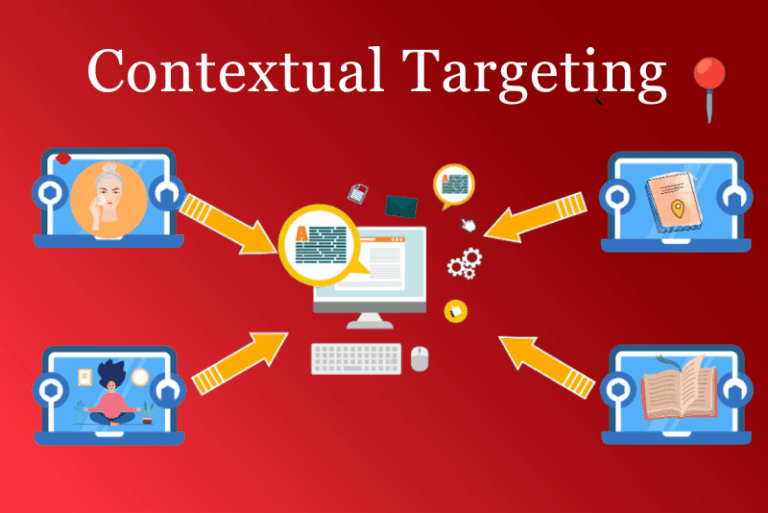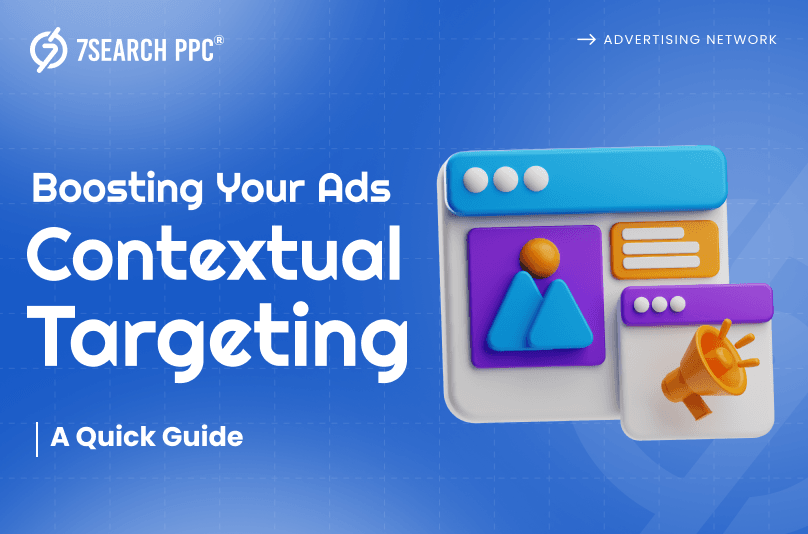Hey folks, what’s up? We hope you are celebrating the new year to the fullest. Do you know why we are here? We are here to add some extra spices to your celebration through our blog.
In this blog, we will provide you with tips that will not only improve your advertising game but also kickstart the year with advertising excellence. Are your ads reaching the audience who are actually looking for them? No?
It is the biggest problem that advertisers are facing nowadays. If you are also facing the same issue, then you need to change your targeting strategy and show trust in contextual targeting.
It is the only hope that will help you tailor your ads to align perfectly with your target audience and make your digital marketing efforts more effective and impactful in the year ahead.
So, readers, make yourself ready and travel with us in the world of contextual targeting where your audience is waiting for you.
Understanding Contextual Targeting For Advertising Success
Contextual Targeting, a most famous advertising strategy among worldwide advertisers, and why it is considered to be the best advertising strategy; let’s find out. It is a strategic approach from the advertiser’s side to display advertisements to the audience who are likely interested in their products and services.
It involves placing ads in online spaces where they align with the content or keywords relevant to the target audience, which leads to increased chances of capturing the right attention and generating effective results. It delivers the advertisements to audiences based on the material they are interacting with, which is the main goal of this advertising strategy.
Advertisers can customize their messaging to match the needs and interests of people by knowing the content that surrounds them. Overall, it is very helpful in establishing a connection between the advertisers and the audience on a deeper level with its targeted advertising concept.
How Does Contextual Targeting Work?
Readers, after understanding contextual targeting, it is essential for you to learn how contextual targeting works because many advertisers often experience confusion between the contextual and behavioral targeting approaches; they think both are the same, but in reality, both are different.
Contextual targeting analyzes a webpage’s content using advanced algorithms and high-level machine-learning techniques to understand the content and types of advertising that perfectly fit that page in digital marketing. In order to determine the context and the applicability of the information, it considers the following elements –
- Sentiment
- Themes
- Keywords
It solves the problems of the advertisers and makes their ads more powerful than ever before. Advertisers can deliver highly relevant ads to a user based on their understanding of the context and current interests or requirements.
For Instance – Suppose you run an organic food company. You can use contextual targeting to place ads for organic food items on web pages that discuss healthy eating.
Types Of Contextual Targeting
There are various types of contextual targeting methods that businesses can use to run ads in digital advertising. Here it is –

- Category Contextual Targeting: Category contextual targeting is the targeting approach that displays ads based on general categories like health, technology, or tourism.
- Keyword Contextual Targeting: Keywords Contextual targeting is like researching and choosing high-performing keywords for your ads. Advertisers choose particular keywords relevant to their offerings, and display ads on websites or pages containing those keywords.
- Semantic Contextual Targeting: Semantic contextual targeting is considered to be the most advanced technique used by advertisers. It uses machine learning to analyze web page context for better ad placement.
The Winning Edge Of Contextual Targeting
Contextual Targeting offers several benefits over traditional advertising methods that rely on demographic or behavioral targeting. Let’s learn some of these advantages in detail
Enhanced Relevance
The first benefit of using contextual targeting is its power of relevancy. Do you know what is the biggest challenge for advertisers in the world of online advertising? The biggest challenge is to display ads to the audience without making them angry or annoyed.
The ability to show users extremely relevant advertisements is one of context targeting’s greatest benefits. It increases the probability that users will interact with the advertisements and perform the intended action.
Improves User Experience
Many advertisers spend lots of money on advertisements but do not get the desired results, and the reason is the selection of an advertising approach that does not focus on improving the user experience.
Contextual targeting is not like that; It appears as adverts that blend in naturally with the content of the webpage, as opposed to spamming people with irrelevant ads that break up their browsing experience. In doing so, the ads increase the likelihood that users will find them acceptable and form a strong bond with the brand.
Cost-Effectiveness
Are you investing in an advertising approach that only provides you with unnecessary ad impressions and clicks from the non-convertible audience? Please stop investing in that advertising approach because it is going to be expensive for you.
You can use contextual targeting for your online marketing strategy because it maximizes your ad expenditure by contacting visitors who are more likely to be interested in your offerings by targeted advertising based on the webpage’s content. It ensures that every penny you are invested in digital ads is profitable.
Increased Brand Safety
One of the biggest concerns for advertisers is brand safety. In contextual targeting, ads are shown in a suitable and safe environment, which helps advertisers protect their brand image and reputation in Internet marketing.
Advertisers can prevent their brand from being associated with content that is controversial or of low quality. It places its ads on websites that are trustworthy and relevant. It keeps the audience confident and upholds the reputation of the company.
Enhances ROI
Contextual advertising is the best performer in the paid advertising approach. According to the Analytic Partners, contextual targeting has been identified as 1.2 to 2.5 times more effective than other forms of targeting.
It helps advertisers improve and raise the return on investment (ROI) by ensuring that ads are strategically placed in contexts aligned with their target audience’s interests. The increment in the ROI is a positive sign for advertisers that their strategy is going on the right path.
Practical Steps For Applying Contextual Targeting
Implementing contextual targeting in your ads requires a strategic approach. We have researched the following steps that will help you in achieving your advertising objectives quickly –
Pick Out The Audience You Want To Reach
It is essential to pick out your target audience precisely before implementing contextual targeting. You must recognize their interests, preferences, and the topic or subjects they are most inclined to discuss. It will not only ensure optimal relevance but also allow you to align your adverts with the appropriate web pages.
Choose Relevant Keywords
Once you have a good understanding of your target audience, the next step is to find out which keywords are most relevant to your offering. As an advertiser, it’s crucial to identify the relevant keywords as they ensure that your ads are displayed on the right websites. To find high-quality keywords that are relevant to your business, you can use the following keyword research tools –
- Google Keyword Planner
- Ahrefs
- Keyword Surfer
- Moz Keyword Explorer
Set Your Campaign Goals
Suppose you want to run a contextual targeting campaign through our 7SearchPPC ad network. The following step is to define the theme of your ads. It involves a general category that suits your ads, such as travel, e-commerce, etc. It is the most crucial step in contextual targeting to make your advertising efforts successful.
Select Appropriate Advertising Formats
As an advertiser, it is essential to choose ad formats that work well with contextual targeting. You can research the ad formats from various sources, such as YouTube. You can also visit the 7SearchPPC’s blog section to learn about the ad formats.
Use Relevant Content And Images
Relevant content and images play an important role in contextual targeting. You can create content that sets seamlessly with the interests and preferences of your target audience. You must focus on creating content that is more appealing and relevant to their needs. In just the same way, you must add images that silently convey the message to the visitors and attract them to your products and services.
Regular Monitoring For Better Results
If you want to sit at the new height of success, then you should have to change yourself to an active advertiser. You must keep a close eye on the effectiveness of your contextual targeting strategy and tweak it as necessary. You must examine the following data to find areas for improvement –
- Engagement Rates
- Conversions
- Click-Through Rates (CTR)
You must make sure that your advertisements are constantly producing the best results by consistently adjusting your campaign.
Contextual Brilliance: 4 Standout Examples
We have researched the four examples of successful contextual advertising campaigns that demonstrate the effectiveness of this strategy:
Amazon
The targeting strategy of Amazon is the best example to understand how big e-commerce companies use contextual targeting to grow their business. Suppose you just looked on Amazon for camping gear. Afterward, when you browse other product categories like sports shoes, Amazon uses your past search history to show you contextual adverts for items related to camping.
Spotify
We all use music apps to listen to songs according to our moods. Let’s pick a famous music app, Spotify; suppose you use Spotify to listen to fitness playlists on a regular basis. During your listening sessions, the site or app delivers contextual advertising to show your advertisements for sportswear, neckbands, fitness applications, etc.
Netflix
Many people love to watch movies or websites through OTT platforms rather than going to the movie hall, and I think you are also the same. Right? Yes, we knew it. Ok, let’s take an example of the famous OTT platform, and its name is Netflix. Suppose you’ve been viewing a lot of crime documentaries on Netflix. It recognizes your interest in a particular genre and utilizes contextual advertising to promote the latest or upcoming thriller trailer in between episodes.
Uber
Uber is a well-known brand that makes its impact all over the world, especially in the USA. Suppose you are returning home from your friend’s party, and you booked a ride with Uber. It quickly recognizes that a user may be interested in ordering food after a night out and begins to display contextual advertisements for food delivery services during those hours.
Conclusion
Contextual targeting has a lot to offer marketers looking to improve the effectiveness of their ads. This blog simplifies more than half of your work. Now, it’s your turn to complete the rest of things by applying the contextual targeting strategies in your online marketing strategy. You can share this blog with fellow advertisers to educate them about this underrated strategy and give them a reason to smile. Happy Advertising!
Frequently Asked Questions (FAQs)
How does machine learning enhance contextual targeting?
Ans. Machine learning algorithms analyze content and learning patterns to understand context and help advertisers put their ads where they are most likely to attract an audience.
What are the future trends that we can expect in contextual targeting?
Ans. There are the following future trends that you may expect in contextual targeting –
- Advancement In Machine Learning
- Increased Personalization
- Emerging Technologies
How can I measure the success of contextual targeting?
Ans. Dear friend, you can measure the success of contextual targeting through the following metrics –
- Conversion Rates
- Click-Through Rates
- Audience Engagement
















